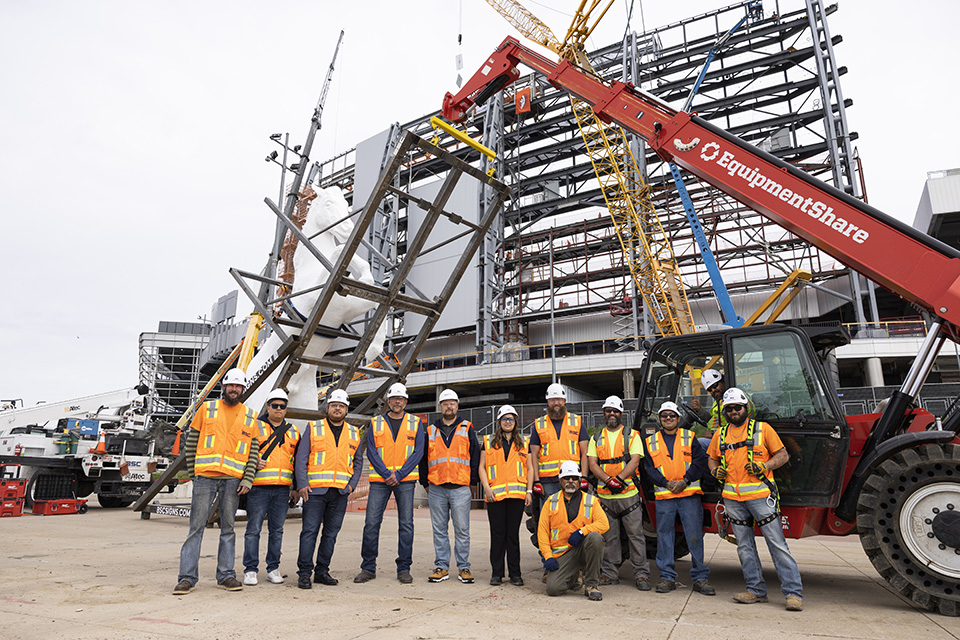When the NFL’s Denver Broncos organization entrusted BSC Signs with the refurbishing project for their home stadium, Empower Field at Mile High, it was a task they considered “irreplaceable” and “priceless.” BSC Signs assembled a dedicated team of managers, designers, fabricators, and installers to ensure the success of the project. Their goal was not only to satisfy the Broncos but also to leave a lasting mark with their work.
In January 2022, the Broncos initiated a $100 million expansion and upgrade project for their stadium, part of which involved doubling the height of the scoreboard to seventy feet. Alongside this, they decided it was an opportune moment to renovate the iconic white fiberglass horse sculpture known as “Bucky,” which had adorned the scoreboard since 1975.
Interestingly, the mold for this fiberglass sculpture had a unique history, as it was originally used for a full-scale replica of Roy Rogers’s famous horse co-star, Trigger, for the Roy Rogers-Dale Evans Museum in Apple Valley, California. Roy Rogers approved its use under two conditions: that the new horse wouldn’t be named “Trigger” and that the mold would be destroyed afterward. The sculpture’s name, “Bucky,” actually came from a radio station contest, evolving from the initial choice of “Bucko.”
Mortenson Construction, the general contractor responsible for the scoreboard renovation, subcontracted the Bucky refurbishment project to BSC Signs, a well-established custom sign company located in Broomfield, Colorado. BSC Signs had an advantageous position for securing this project due to their long-standing working relationship with Mortenson Construction on previous complex and custom projects.
According to BSC Signs Owner Joe Landin, his company had cultivated a strong collaborative partnership with Mortenson Construction over the years, making them the go-to choice for intricate projects. Furthermore, they had indirect interactions with some members of the Broncos organization. Joe Landin, who took over ownership from John Dobie in early 2021, has been leading the company with a commitment to excellence since he was profiled as “SBI Young Sign Maker 2021.”
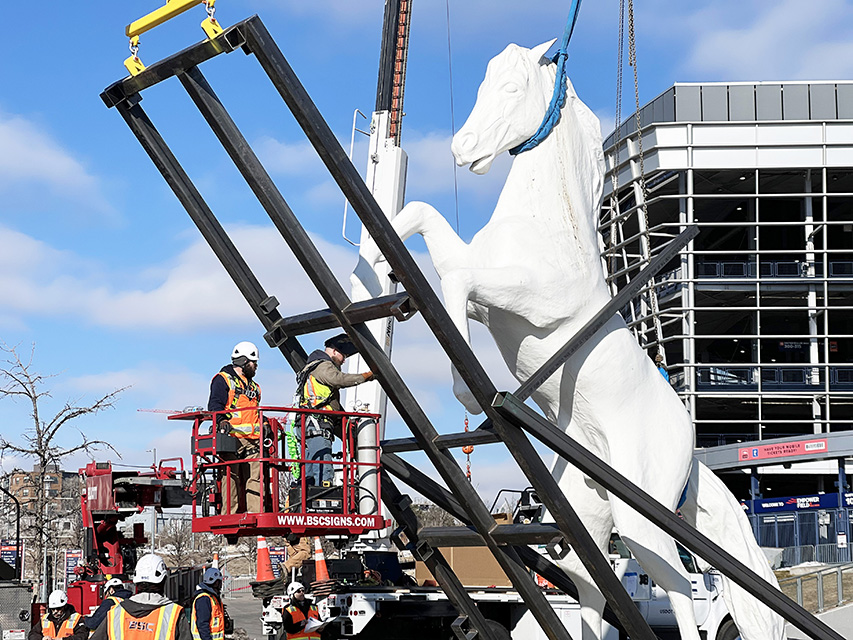 Removing the Bucky sculpt from its perch.
Removing the Bucky sculpt from its perch.
Another significant advantage for BSC Signs was their prior experience with a smaller-scale Bucky piece, which they had built and installed in 2015. This mini-Bucky proudly stands atop the downsized replica Mile High Monument located in the Lot J parking area of Empower Field at Mile High.
However, this current project presented some notable differences. The Bucky sculpture to be refurbished was nearly twenty-five feet in height and weighed approximately 1,300 pounds, making it a substantial and challenging undertaking compared to their previous work.
The Game Plan
The initial task at hand was to assess the extent of the work required to modernize Bucky. While Bucky was still mounted on the scoreboard, it was challenging to obtain a comprehensive understanding of its condition. To gain a more accurate assessment of the necessary fiberglass repairs, a ground-level inspection was deemed essential.
To facilitate this inspection, the team responsible for erecting the steel framework for the billboard renovation utilized a boom lift to reach the statue’s height. They carefully affixed a harness to the white fiberglass statue, then disengaged it from its fastenings before carefully lowering it to the ground using a crane. This allowed for a thorough examination of Bucky’s condition and the determination of the required restoration efforts.
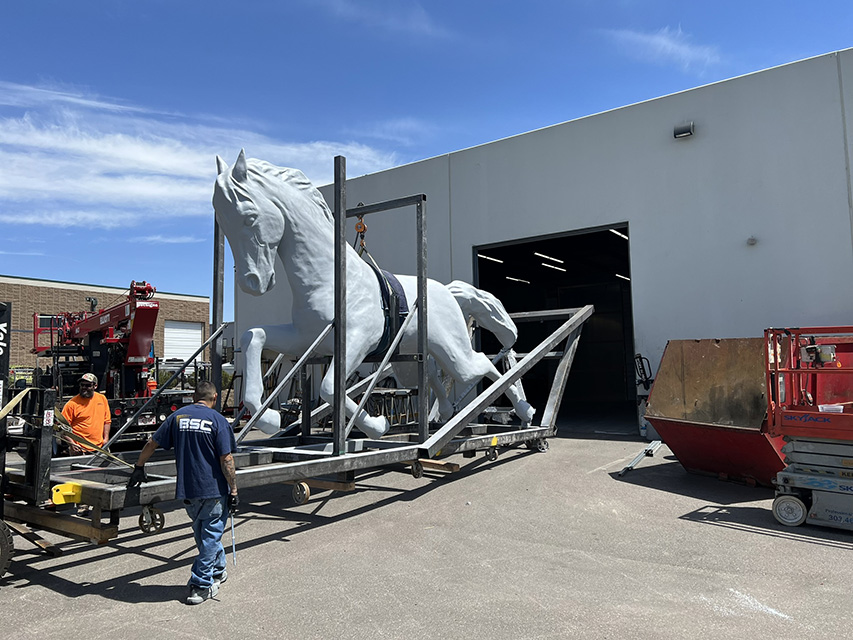 Mobility around the BSC Signs facility.
Mobility around the BSC Signs facility.
B
Following the careful lowering of Bucky to the ground, the team at BSC Signs proceeded to place the sculpture on a specially constructed mounting structure, a product of their own craftsmanship. This structure was purpose-built to facilitate the safe transportation of Bucky to the sign company’s facility for a more detailed inspection.
An interesting note is that originally, BSC Signs had intended to move Bucky around their facility using a large telehandler. However, they quickly realized that this approach would be unwieldy. To enhance mobility and ease of transportation, they ingeniously affixed twelve large, high-capacity steel wheels to an oversized, custom-built steel frame.
Upon closer inspection, it became evident that several damaged areas on the sculpted horse were immediately visible, along with some chipped paint in the vicinity of these spots. As the BSC Signs team began sanding these areas, they soon discovered that the extent of the damage was more significant and worrisome than initially anticipated. Joe Landin, the company owner, explains that what initially seemed like a two-inch crack, upon sanding, revealed itself to be a six-inch crack that had been concealed beneath layers of paint or coating.
 Inspecting Bucky.
Inspecting Bucky.
Following the thorough sanding process, a specialized fiberglass engineer was brought in to conduct a more comprehensive evaluation of Bucky’s structural integrity. To gain deeper insights, they implemented various diagnostic techniques.
The engineer drilled holes at strategic mounting points and inserted cameras to provide a visual examination of the interior. Additionally, they performed sonic testing to measure the wall thickness and identify potential structural weaknesses.
Based on the engineer’s findings, the recommendation to the Broncos organization and Mortenson Construction was to remove all the layers of coating on Bucky through a process known as media blasting. This approach would unveil any underlying issues with the fiberglass that might not be immediately visible, ensuring a complete understanding of the sculpture’s condition.
Joe Landin noted, “Bucky had several layers of coating. It appeared that there was a high-quality base coat of paint, likely applied with brushes or rollers, which had been overlaid with subsequent layers.”
 The media blasting process.
The media blasting process.
The most efficient method chosen for removing the existing coating without causing damage to the fiberglass was to employ powdered glass media for the sandblasting process.
For the fiberglass sandblasting, BSC Signs enlisted the services of H&S Sandblasting. To ensure that Bucky remained protected from the elements during the media blasting process, BSC Signs constructed a custom modular wall outside their facility, forming a three-sided enclosure that attached to Bucky’s steel structure.
The media blasting procedure spanned a week, during which Bucky was temporarily relocated out of the shop for blasting each day and then moved back inside at day’s end.
The initial coating was relatively straightforward to remove, but the original gel coat proved more resilient, demanding the use of two blasters, larger nozzles, and a more generous amount of powdered glass.
Upon completing the blasting, it was discovered that Bucky exhibited some transparency in certain areas. Joe Landin observed, “In some regions, we noticed that the walls were thinner than expected. We initially believed he had a 3/16-inch coating all around, but in some parts, it was slightly thinner than that.”
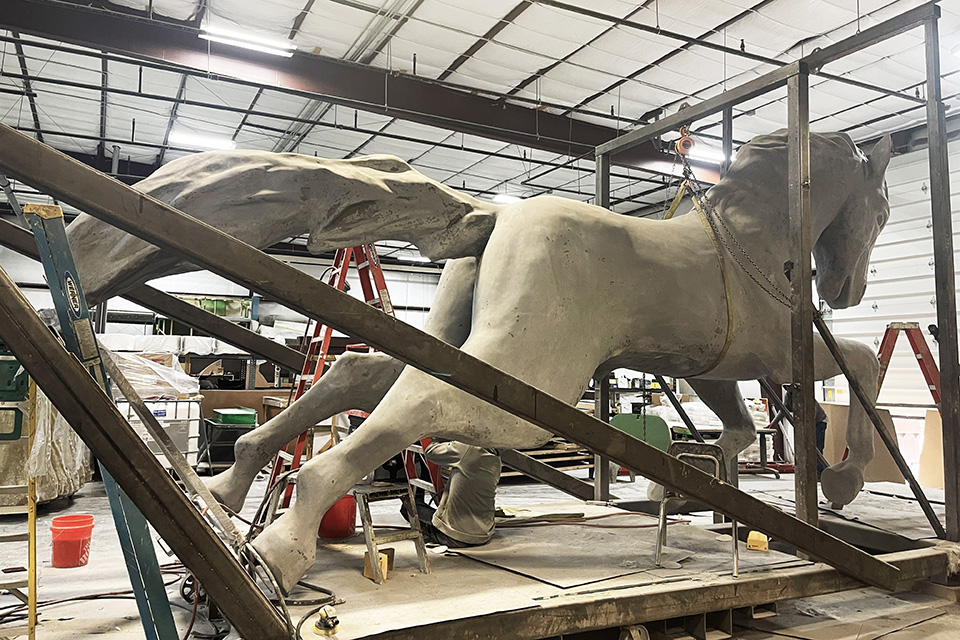 The fiberglass coating process.
The fiberglass coating process.
As the project progressed, it became evident that some of the damaged areas on Bucky were more extensive than initially assessed. At this juncture, the fiberglass engineer recommended a comprehensive re-coating with a full 3/16-inch layer of fiberglass, effectively doubling the original thickness. Furthermore, to reinforce the structural integrity, the engineer suggested the addition of structural foam inside the horse’s hind legs and tail area, where the mounting points were located.
E&J Fiberglass was tasked with carrying out the full fiberglass recoating process. To inject the foam, they drilled holes into the designated areas. Joe Landin explains, “I was told that it hardened within minutes.” Subsequently, these drilled areas were meticulously patched to ensure a seamless finish.
This timeline presented a significant challenge as the initial plan was to remove Bucky from its scoreboard perch in late January and have it reinstalled by mid-June. However, midway through the project, BSC Signs received the news that the installation date had been moved up to mid-May. This change in schedule compressed their timeline to approximately eight weeks, which meant they had to expedite the full fiberglass re-coating, manage the coatings, transportation logistics, and more.
Joe Landin underscores the critical role of factors like drying times, warranties, support, and responsiveness in successfully meeting this condensed timeframe. Denco Tubelite served as their distributor for this project, aiding in the efficient execution of these critical aspects.
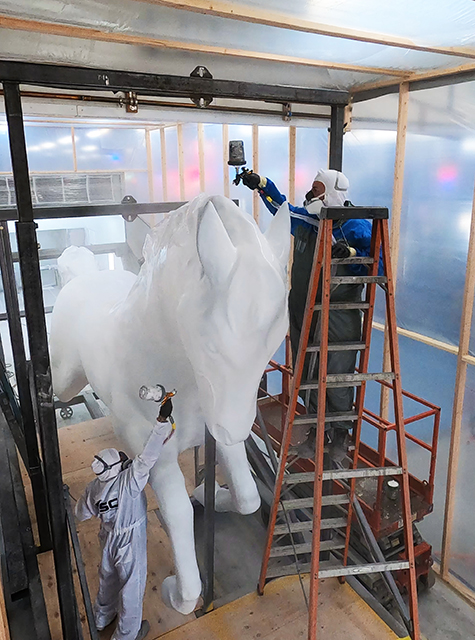 The painting stage.
The painting stage.
In the process of selecting the coatings for the project, Joe Landin was particularly impressed with the support offered by AkzoNobel, who went the extra mile by offering to send some of their team members to assist with the painting process.
Given Bucky’s massive size, even BSC Signs’ spacious 21,000-square-foot manufacturing facility had its limits. Therefore, they had to create a temporary paint booth outdoors to accommodate the project’s unique requirements. Constructing this outdoor booth took approximately a week, involving tasks such as procuring lumber, securing frames to the ground, and installing the necessary sheeting.
Landin explains the approach, “We wanted it to pull air and create suction. We built a custom door that opens and closes, equipped with real paint booth filters to ensure the intake of clean air. Essentially, we extended our existing booth as much as possible to achieve the optimal paint booth environment.”
The AkzoNobel team flew in to oversee the mixing process and offer product guidance to BSC Signs’ internal paint team. Inside the paint booth, there were four painters, with three guns simultaneously spraying Bucky. Due to the tight schedule, AkzoNobel had to leave after assisting with the undercoat, basecoat, and the first two clear coats. BSC Signs’ team then took over to apply the final two clear coats and complete the polishing process.
 The buffing stage.
The buffing stage.
The actual painting process, encompassing the sealer, base, and clear coats, spanned approximately three days. Following the completion of the painting, the polishing phase extended for about a week. This involved a wet sanding of Bucky after all the clear coats had been applied. Joe Landin elaborates, “It was a two-step polishing phase—we initially polished him with the first round of polish and then applied another round to blend everything in.”
The result of this meticulous process is that Bucky now boasts a robust protective coating, including a 3/16-inch epoxy resin fiberglass layer, a fiberglass gel coat primer, an Evercoat Feather Fill® coat to address any imperfections from the gel coat primer, and two applications of AkzoNobel sealer coat.
To further enhance appearance and provide added protection, two coats of white AkzoNobel paint were applied, followed by four coats of AkzoNobel clear coat. Subsequently, Bucky underwent buffing and polishing to achieve a pristine finish.
The expectation is that these coatings on the refurbished Bucky will ensure its longevity for at least a minimum of ten years, and quite possibly even longer.
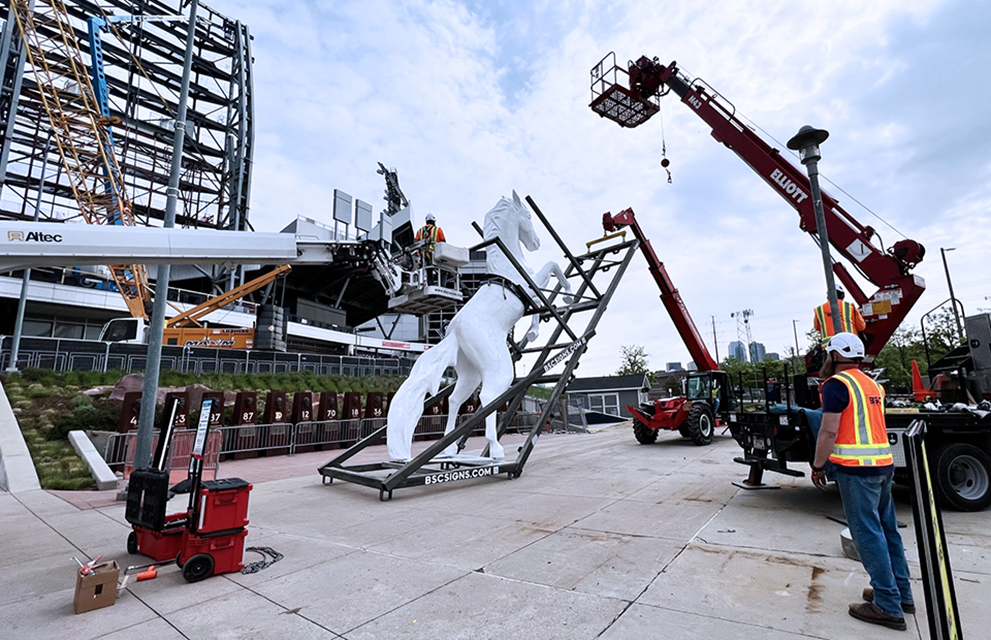 Preparing for installation.
Preparing for installation.
During the polishing phase, members of the Denver Broncos organization visited the facility to conduct an inspection. Joe Landin proudly recalls their visit, stating, “When they inquired if we were still on schedule, I responded, ‘It felt like we were ahead of it!'” The positive feedback from the Broncos team was a testament to the diligent work of BSC Signs.
Following the polishing phase, BSC Signs proceeded to reinforce Bucky by adding steel bracing. They then reassembled the walls onto the mounting structure and prepared him for transportation. Bucky was loaded onto a flatbed trailer for his journey back to Empower Field at Mile High.
At Empower Field, the BSC Signs installation team meticulously staged and prepared for Bucky’s reinstallation. With the assistance of the steel erection and crane company, Bucky was crane-lifted back into position atop the video scoreboard. He was securely fastened with three tightened bolts.
As a result of the scoreboard expansion, the newly reinforced Bucky now stands 31 feet taller than before, soaring to a height of 161 feet above the field. The structural foam and additional coatings have added approximately 500 to 800 pounds to Bucky’s original, unofficial weight of 1,300 pounds.
Post-game Recap
The Denver Broncos organization and Mortenson Construction expressed immense satisfaction with the outcome of the refurbished Bucky. Joe Landin enthusiastically recounted their feedback, saying, “The team president told us he looked great up there, and I told him, ‘Yep, he’s the icing on the cake.’ He’s the prize piece up there!”
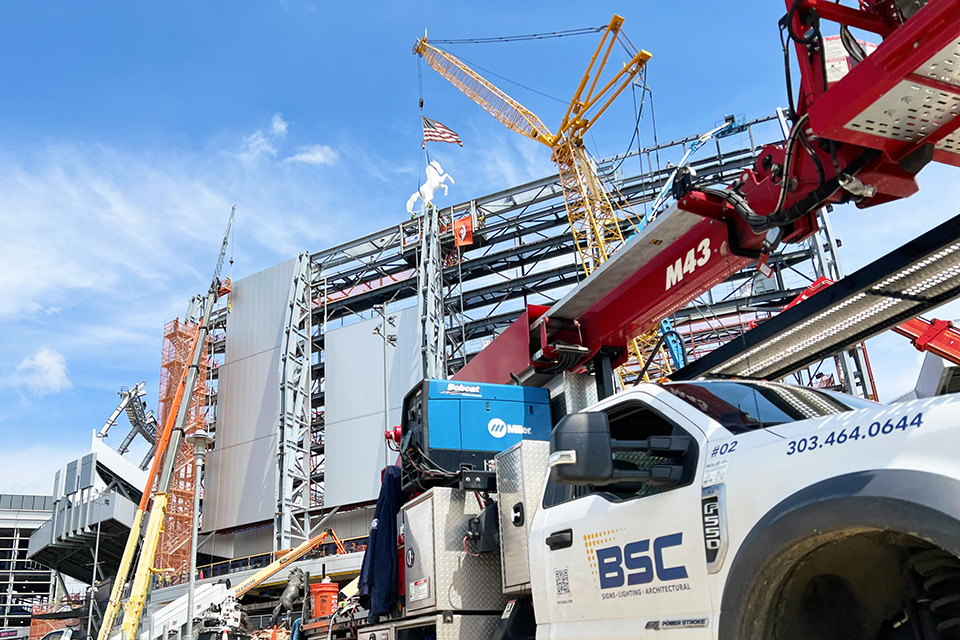 The refurbished Bucky placed back atop the new Denver Broncos scoreboard.
The refurbished Bucky placed back atop the new Denver Broncos scoreboard.
Joe Landin was well aware that the Denver Broncos and Mortenson Construction had a deep, implicit trust in his company. He explained, “We had all our plans in place and addressed all their inquiries. They conducted site visits to monitor our progress and workmanship to ensure we were on schedule. They didn’t need to micromanage us or dictate how to do things because they knew we weren’t cutting corners or taking shortcuts.”
Over time, this established trust led to fewer site visits from the Broncos and Mortenson Construction. Landin was excited and honored that his company had been selected to restore Bucky to its former glory. He noted, “We’re currently in a growth phase and starting to secure larger projects like this one. I’m confident that we’ll continue to receive more opportunities as word spreads.”
Ultimately, Landin credited his vendors and subcontractors for playing a pivotal role in the project’s success. He emphasized the importance of strong relationships with vendors, suppliers, and distributors, stating, “It was fantastic to see everyone come together and rally behind us to ensure our success. Building and maintaining strong relationships with your partners is vital, and when you take care of them, they reciprocate by taking care of you.”
